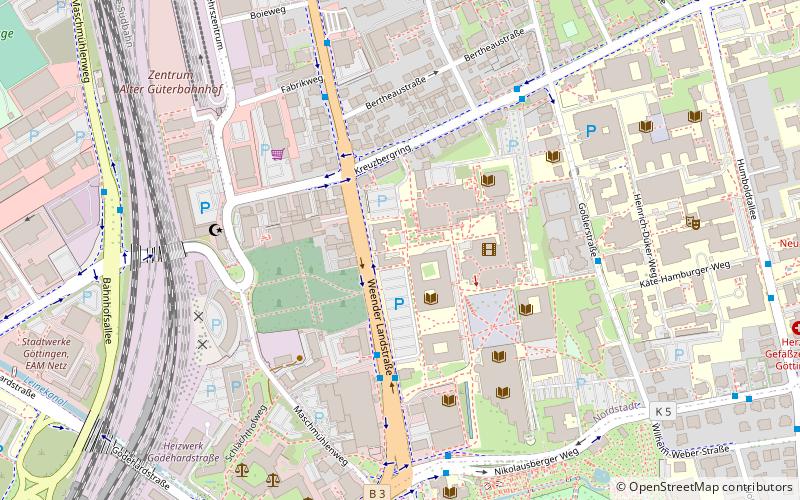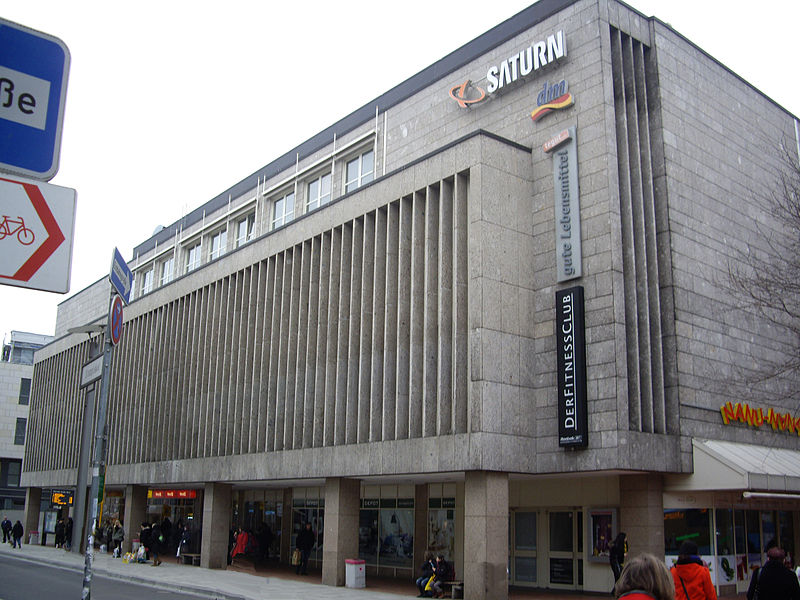Portal des ehemaligen Universitätsreitstalls, Göttingen


Facts and practical information
The University Riding Stables of the Georg-August University of Göttingen was a complex of buildings with outdoor grounds at the northwest end of Weender Straße in Göttingen and consisted of an indoor riding arena, an outdoor riding arena, stables, and a residence for the stable master. The complex was completed between 1734 and 1736 on what was then known as Freudenberg and was one of the first buildings to be rebuilt for the university, which opened in 1734 and was ceremonially inaugurated in 1737. The architect was monastery master builder Joseph Schädeler, who was also responsible for the construction of the university's college and library building and the Londonschänke, later Michaelishaus.
The Hanoverian minister and first curator of the new Göttingen University, Gerlach Adolph von Münchhausen, explicitly planned it for George II as a university for the rich. From his point of view, the target group were especially noble students, if possible with their own retinue. These had to pay double the fee of non-nobles, for example, when riding. This required on the part of the new foundation not only a qualified staff of distinguished scholars of the four classical faculties, but also the promotion of then fashionable sports and manners. These included dancing, horseback riding, fencing and hunting, even the professional carving of game was taught to the students.
Göttingen, still scarred by the aftermath of the Thirty Years' War, offered fewer prerequisites in this respect than, for example, residential towns of small German states. On Münchhausen's initiative, therefore, the riding hall of the new university was erected as one of the new buildings. It was a six-axis structure with a large central portal with a classicist gable under a hipped roof. The baroque structure was made of quarry stone and was bordered with house stone at the corners. The window reveals were also made of house stone. The university riding stables in Göttingen were highly regarded in Germany, especially during the Rococo period for the high school of riding practiced here, and thus signified a clear unique selling point compared to other German university towns.
The best in the business were engaged as riding instructors; this began with Valentin Trichter and continued with Johann Heinrich Ayrer and his son Ernst Ferdinand. When Goethe came to Göttingen, he absolutely had to take riding lessons from Ayrer. The salary of the university riding instructors corresponded to that of the professors. At the ceremonial opening of the semester, they went after the full professors, but before the associate professors, which regularly caused trouble, since at other universities they only moved in with the lecturers and language teachers. In order to avoid a position in the riding stable of the King of Saxony, Ayre's salary was doubled, but the King of Prussia then offered another double salary, so that he then went to Potsdam. In Ayrer's day, five percent of the student body had enrolled in ars equitandi, although it was not an actual field of study. Ayrer also gave the first equine medical lectures, the beginning of the Veterinary Institute of the Georg-August University in Göttingen.
In the second half of the 19th century, dressage riding took a back seat to hunting riding among the students due to fashion. The connection of Göttingen to the railroad network in 1854 also led to fewer students keeping horses in Göttingen. At the same time, the importance of student fencing increased around the middle of the 19th century with the move away from pure dueling to determination mensuration, and the demand for cramming grounds to hold fencing lessons increased rapidly. Thus, the conversion of the riding hall into a fencing hall was considered but ultimately not implemented. Instead, in 1903 the university opened a purpose-built fencing hall at Geiststraße 6, where the university's fencing masters gave their lessons from then on.
During World War I, the university came to an almost complete standstill, and the need for this institution dwindled along with the students. The area of the riding stable district became the focus of Göttingen's urban planning even before the Second World War. After World War II, the riding stable was used for vaulting, which was first resumed here in 1950. A show troupe was established, which had the same function as the "Seideltruppe". The vaulters increasingly organized themselves into clubs and held their own tournaments. The first was held in 1953 in Göttingen at an equestrian tournament.
In 1966, the city acquired the land with the listed riding stable building against the backdrop of plans to build a city hall, swimming pool, adult education center, public library and parking garage on the site. At the end of 1967, demands were voiced in the town council to preserve the building and to reuse it, for example as a student center. In the summer of 1968, the riding stable building was demolished by the city against massive protest from the population and the student body.
The enormous natural stone portal was put into storage. The planning on which the demolition decision was based was never realized. The site initially served as a parking lot on the edge of downtown Göttingen for several years. In 1974, Hertie built a department store on the site, but abandoned its use as early as 1986. After a few years of vacancy, the department store building was converted into a passage for smaller retail businesses and has since been used in this form under the name Carrée. A major renovation occurred in 2014.
The stored portal of the former university riding stables was rebuilt in 1974 in isolation on the then new campus of the Humanities Center.
Nordstadt (Humboldtallee)Göttingen
Portal des ehemaligen Universitätsreitstalls – popular in the area (distance from the attraction)
Nearby attractions include: Alter Botanischer Garten, Gänseliesel, SS. Peter and Paul's Church, Naturerlebnisbad Grone.
Frequently Asked Questions (FAQ)
Which popular attractions are close to Portal des ehemaligen Universitätsreitstalls?
How to get to Portal des ehemaligen Universitätsreitstalls by public transport?
Bus
- Platz der Göttinger Sieben • Lines: 180, 185, 21, 22, 23, 31, 32, 34, 91, E, E31, N2, N3, N4 (3 min walk)
- Kreuzbergring • Lines: 180, 185, 31, 32, E (5 min walk)
Train
- Göttingen (12 min walk)











